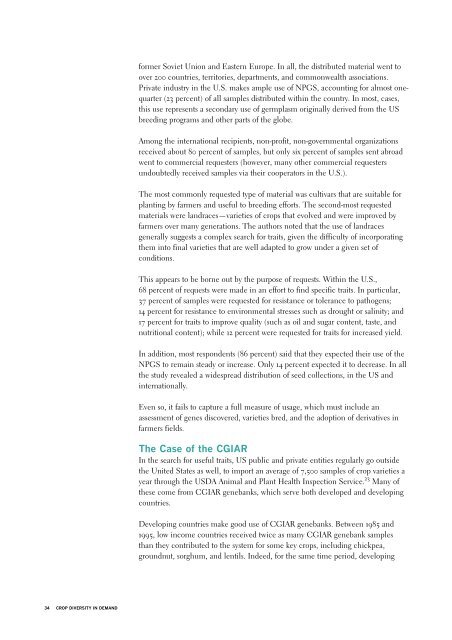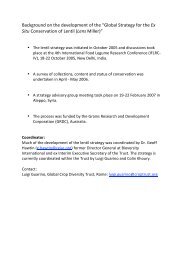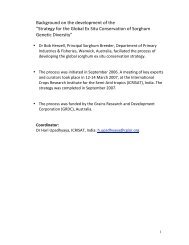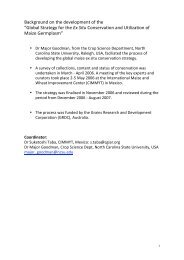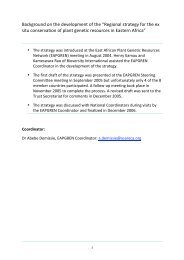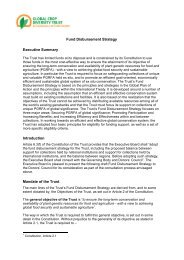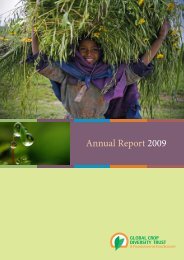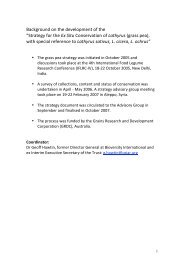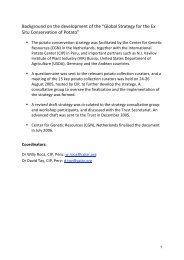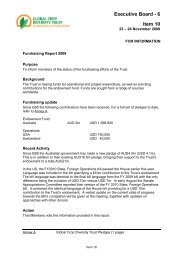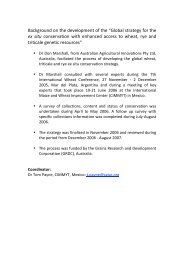Safeguarding the Future of US Agriculture - Global Crop Diversity Trust
Safeguarding the Future of US Agriculture - Global Crop Diversity Trust
Safeguarding the Future of US Agriculture - Global Crop Diversity Trust
Create successful ePaper yourself
Turn your PDF publications into a flip-book with our unique Google optimized e-Paper software.
former Soviet Union and Eastern Europe. In all, <strong>the</strong> distributed material went toover 200 countries, territories, departments, and commonwealth associations.Private industry in <strong>the</strong> U.S. makes ample use <strong>of</strong> NPGS, accounting for almost onequarter(23 percent) <strong>of</strong> all samples distributed within <strong>the</strong> country. In most, cases,this use represents a secondary use <strong>of</strong> germplasm originally derived from <strong>the</strong> <strong>US</strong>breeding programs and o<strong>the</strong>r parts <strong>of</strong> <strong>the</strong> globe.Among <strong>the</strong> international recipients, non-pr<strong>of</strong>it, non-governmental organizationsreceived about 80 percent <strong>of</strong> samples, but only six percent <strong>of</strong> samples sent abroadwent to commercial requesters (however, many o<strong>the</strong>r commercial requestersundoubtedly received samples via <strong>the</strong>ir cooperators in <strong>the</strong> U.S.).The most commonly requested type <strong>of</strong> material was cultivars that are suitable forplanting by farmers and useful to breeding efforts. The second-most requestedmaterials were landraces—varieties <strong>of</strong> crops that evolved and were improved byfarmers over many generations. The authors noted that <strong>the</strong> use <strong>of</strong> landracesgenerally suggests a complex search for traits, given <strong>the</strong> difficulty <strong>of</strong> incorporating<strong>the</strong>m into final varieties that are well adapted to grow under a given set <strong>of</strong>conditions.This appears to be borne out by <strong>the</strong> purpose <strong>of</strong> requests. Within <strong>the</strong> U.S.,68 percent <strong>of</strong> requests were made in an effort to find specific traits. In particular,37 percent <strong>of</strong> samples were requested for resistance or tolerance to pathogens;14 percent for resistance to environmental stresses such as drought or salinity; and17 percent for traits to improve quality (such as oil and sugar content, taste, andnutritional content); while 12 percent were requested for traits for increased yield.In addition, most respondents (86 percent) said that <strong>the</strong>y expected <strong>the</strong>ir use <strong>of</strong> <strong>the</strong>NPGS to remain steady or increase. Only 14 percent expected it to decrease. In all<strong>the</strong> study revealed a widespread distribution <strong>of</strong> seed collections, in <strong>the</strong> <strong>US</strong> andinternationally.Even so, it fails to capture a full measure <strong>of</strong> usage, which must include anassessment <strong>of</strong> genes discovered, varieties bred, and <strong>the</strong> adoption <strong>of</strong> derivatives infarmers fields.The Case <strong>of</strong> <strong>the</strong> CGIARIn <strong>the</strong> search for useful traits, <strong>US</strong> public and private entities regularly go outside<strong>the</strong> United States as well, to import an average <strong>of</strong> 7,500 samples <strong>of</strong> crop varieties ayear through <strong>the</strong> <strong>US</strong>DA Animal and Plant Health Inspection Service. 23 Many <strong>of</strong><strong>the</strong>se come from CGIAR genebanks, which serve both developed and developingcountries.Developing countries make good use <strong>of</strong> CGIAR genebanks. Between 1985 and1995, low income countries received twice as many CGIAR genebank samplesthan <strong>the</strong>y contributed to <strong>the</strong> system for some key crops, including chickpea,groundnut, sorghum, and lentils. Indeed, for <strong>the</strong> same time period, developing34 CROP DIVERSITY IN DEMAND


